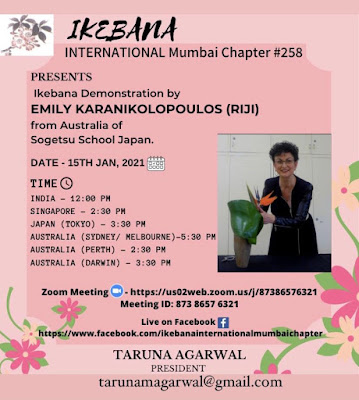 |
| Queen's Tears bromeliad flowers and Pinellia tripartita leaves in ceramic container |
Hello all,
I'd like to start with an announcement that I will be running an Ikebana workshop at the Bulleen Art and Garden Centre on 28th February. For more information please click on the link and then on 'Classes and Workshops' http://www.baag.com.au/
This workshop is one of three that I was booked to conduct last year but were cancelled. I'm happy that things have improved sufficiently to allow for such events to go ahead.
I'm also going to try something I've been wanting to do for some years. I'm going to run an Ikebana Masterclass once a month, beginning in February, for the more advanced students of ikebana. I'm quite excited about this and am really looking forward to it.
After the Zoom demonstration over a week ago, all the surfaces in the house still have arrangements on them. There is nowhere to display any new ones. But I have left over material from the demo as well as new material in the garden that must be used.
In this first one, Vicky gave me three pieces of the fan-aloe (Kumara plicatilis) for the demo. Having used only one, I wanted to play around with another. I love it when I have the opportunity of workshopping some material because I learn about its properties, difficulties etc. In this case, the aloe is soft to the touch but can snap quite easily but, most importantly, it is very heavy. Here's what I did with it.
 |
| Fan Aloe with dahlia in ceramic container |
 |
| Bromeliad Neoregelia and wisteria vine in ceramic container |
 |
| Umbrella grass stems and hydrangeas in ceramic container |
The container in this next arrangement was brought to me by my good friend, Olga when she dropped in recently. She said that she and her daughter came across it and bought it for me. How lucky am I? And this is not the first time Olga did this. I have another container from her from some years ago, which I have used extensively.
 |
| Umbrella grass stems and and leek flowers in ceramic container |
 |
| Before |































